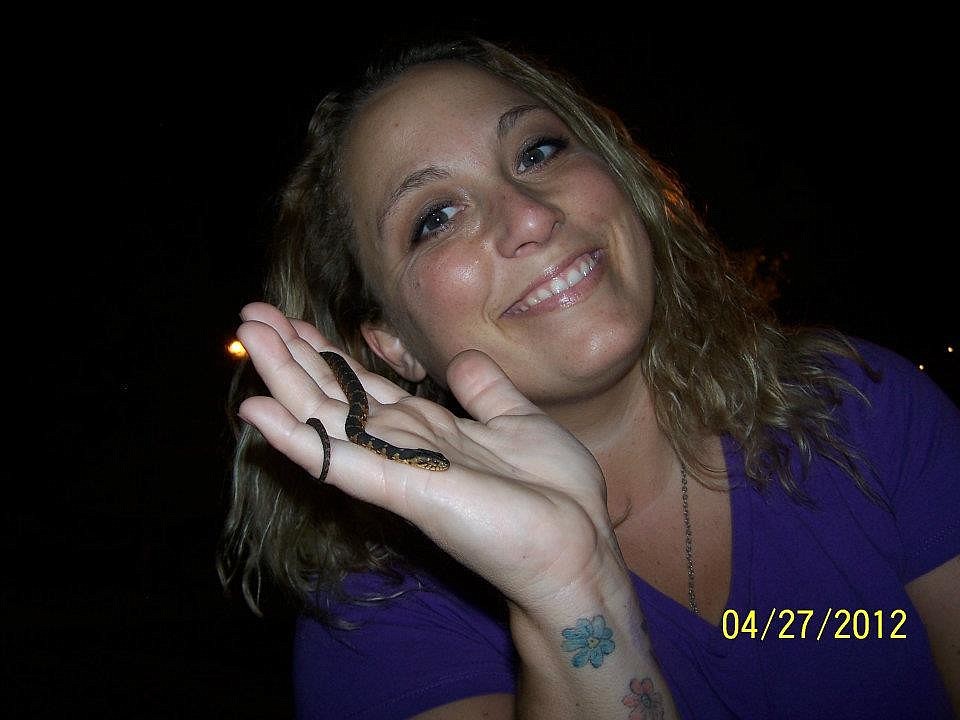- February 26, 2025

The massive rattlesnake’s tail lay across her right hand. Part of its body lay across her left hand.
Its head brushed her boot, ”And that was when my heart stopped for a second,” Jami Lee Oles said.
The snake was 8 feet, 2 inches long — almost record size — and thick and strong as steel cable.
“Her head, when I clenched my fist, was probably bigger than my fist,” Oles said. But, “The more still you are and the more calm your movements are, the more the rattlesnake will calm down. And that’s what she did.”
Oles was learning to handle the snake at a class run through the Marion County Nature Park.
“I learned to regulate my heart rate, regulate my breathing,” she said, as well as “how to use a snake hook, how they really react to you to your fear.”
She wasn’t able to finish the entire program — pregnancy got in the way, and the program later shut down — but she gained enough experience, she said, to qualify for a state-issued permit to handle and relocate native venomous and non-venemous snakes.
Her friends began calling Oles “the Snake Lady.” The name stuck.
Now, she removes snakes, including venomous ones, for people around the county.
She’ll get a call and head out to a local backyard to remove a cottonmouth or a diamondback — her favorite snake, she said, because they’re so quick and so powerful — or a coral snake or pygmy rattler, or one of our local nonvenomous snakes.
Oles likes snakes.
“They’re not mean creatures that are out to get everybody,” she said. “I think if someone were to sit and just watch the patterns and see — it’s very intricate artwork, really.”
Oles started handling snakes as a child when she’d tag along with her brother, picking up snakes out in the woods.
She got her first ball python — a small, typically docile snake known as a good one for first-time owners — when she was 14.
She’s kept nonvenomous snakes as pets ever since.
And, of course, like so many people who handle snakes, she’s been bitten.
Oles said it’s not as bad as it sounds.
“It feels like a pin prick,” she said of bites by the smaller snakes. “Like if you were to take a push pin, it feels like that. It’s really not painful at all; it’s more startling than it is painful. It’s so superficial.”
Bites from the larger nonvenomous snakes, she said, feel a bit like being scraped by glass.
Black racers and garters are the biggest local biters, she said. Both are nonvenomous.
Oles has never been bitten by venomous snakes, which she handles with long catch poles to keep their powerful heads away from her body.
“A rattlesnake can leap about half its body length and come back at you, so you want them far away,” she said.
She did once have a near miss.
She was preparing to feed a mouse to a caged pygmy rattler, a small snake that can be feisty.
“It just missed my pinky,” she said. “I was just a little bit too close. We’d had him in a cage because he was injured, and I was trying to feed him, and he came out from behind his rock and leaped at me.”
Pygmy rattlesnakes are one of four venomous snakes often found in the Flagler County area. The others are diamondback rattlesnakes, cottonmouth water moccasins, and coral snakes.
All of those snakes, except the coral snake, are pit vipers, with fat bodies, triangular heads and venom that can cause severe tissue damage and be fatal if untreated.
But the venom of the coral snake — a delicate, pretty little snake with red, yellow and black rings around its body — is the most potent.
“Coral snakes are extremely deadly,” Oles said. “They have a neurotoxin that shuts down the nervous system.”
People like to identify coral snakes from their similar-looking but nonvenomous cousins by the rhyme, “Red touch black (red rings next to black rings), friend of Jack; red touch yellow will kill a fellow.”
But its best to simply not to handle any snake with that kind of color pattern, Oles said.
For Oles, a holistic health practitioner and yoga and meditation instructor, snake catching is now a small side business, and she gets snake calls two or three times a week.
She charges $40 to remove venomous snakes and $10 for nonvenomous ones, or $30 if she does an area survey and advises residents about keeping snakes away from their homes.
Many of the tips, she said, are simple: keep your grass cut short, keep brush and rock piles away from the house, and remove anything that holds standing water.
“The snakes are out because it’s so hot,” she said. “They have to find water and they have to find shade.”
Lately, she said, she’s seen “a ton” of cottonmouths in the area, and diamondbacks will be birthing in late July through August.
After Oles removes a snake, she relocates it, usually out to the Tiger Bay area or to Ocala National Forest.
But she doesn’t currently have any at home, and now that her kids are older — they’re 11, 13 and 17 — she might try some breeding nonvenomous snakes.
“I believe wholeheartedly that they’re very misunderstood,” she said. “I think they’re graceful. They’re beautiful.”
To contact Oles, call 338-7722. For help identifying a snake, visit her facebook page at facebook.com/pcsnakelady.